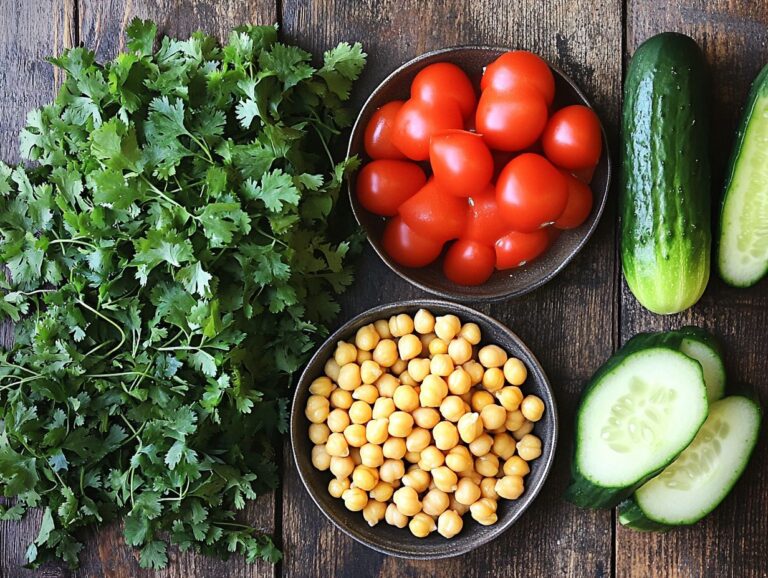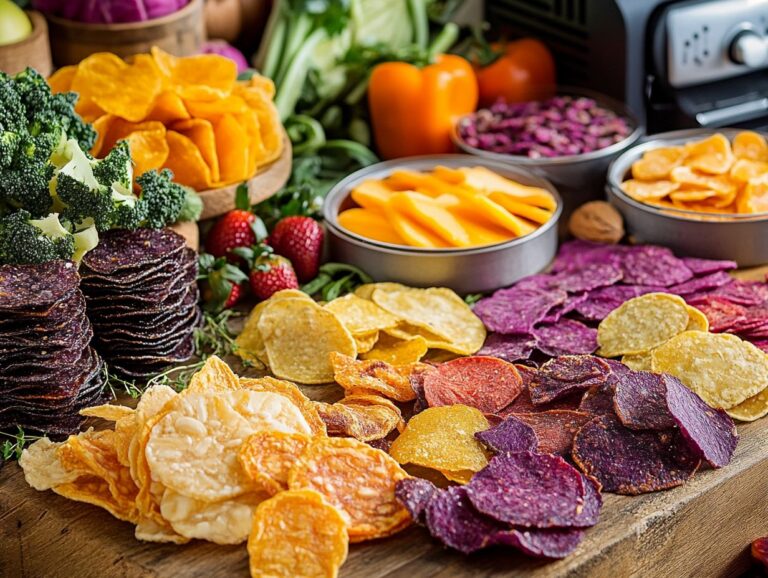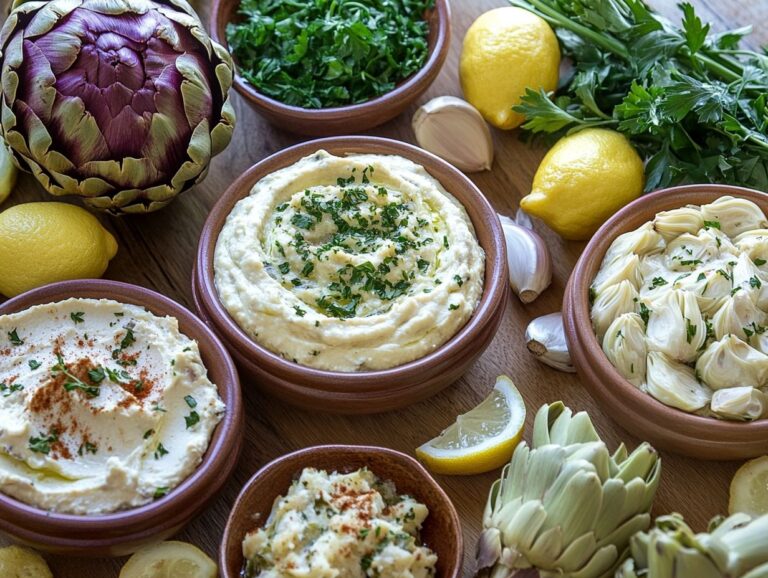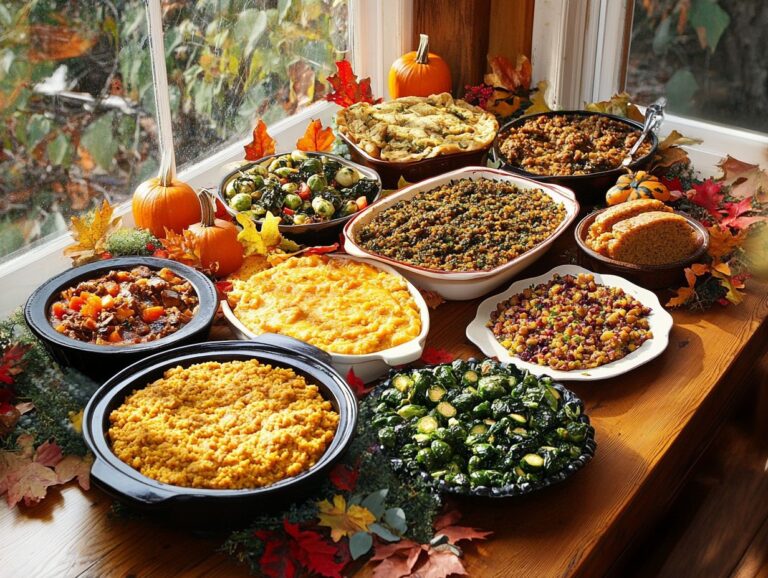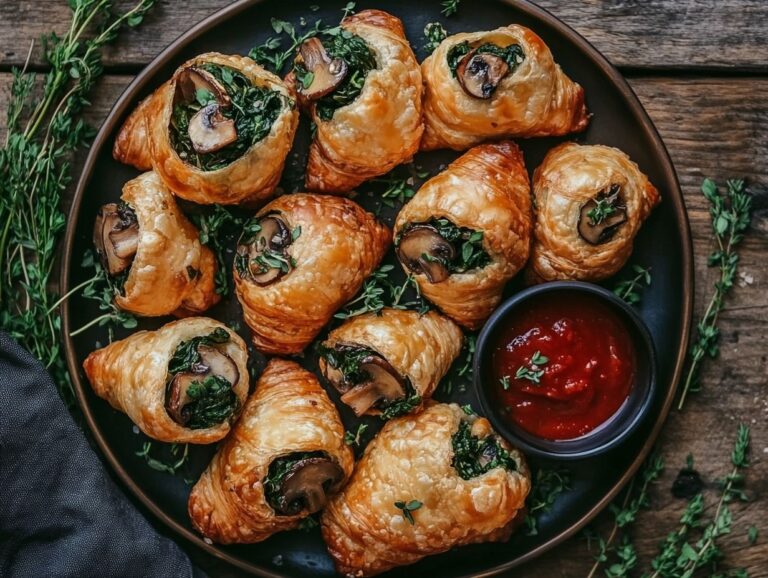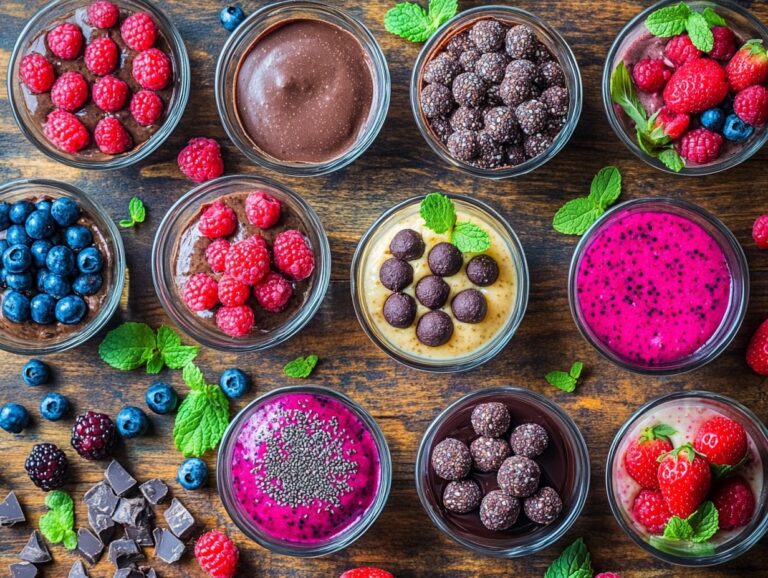The Raw Food Vegan Diet is a way of eating that emphasizes fresh, unprocessed ingredients and offers a variety of health benefits. This diet not only provides numerous nutritional advantages but also practical tips for those looking to make the transition. With delicious breakfast ideas, satisfying lunch and dinner recipes, and tempting snacks and desserts, it becomes easy to incorporate raw veganism into daily life. Explore how this plant-based diet can boost health, enhance your well-being, and invigorate your meals!
The Raw Food Vegan Diet: A Path to Holistic Health
The Raw Food Vegan Diet is a lifestyle choice that emphasizes the consumption of raw and unprocessed plant-based foods, with the belief that these whole foods in their natural state offer optimal nutritional value, rich in vitamins and minerals.
Adherents primarily consume whole foods such as raw fruits, vegetables, nuts, seeds, and sprouted grains. This diet aims to enhance health, promote sustainable eating habits, and support a balanced diet.
Those who follow this diet often report improvements in energy levels, digestion, and immune function, contributing to greater personal well-being, vitality, and overall wellness.
What is a Raw Food Vegan Diet? Understanding the Basics
A Raw Food Vegan Diet primarily consists of uncooked and unprocessed foods, featuring a wide variety of nutrient-dense fresh produce, nuts, seeds, and legumes that are rich in enzymes, antioxidants, and essential nutrients.
This lifestyle emphasizes the consumption of vibrant fruits and vegetables, such as leafy greens, berries, and citrus, all of which are packed with essential vitamins, minerals, and other vital nutrients.
Additionally, superfoods like spirulina, chia seeds, and goji berries provide extra nutritional benefits, promote overall vitality, and support immune health.
In contrast, this diet excludes processed items, dairy, and animal products, favoring a natural approach to nutrition that supports body detox and overall health transformation.
By maximizing the natural enzymes found in raw foods, individuals may experience improved digestion, enhanced energy levels, and a greater sense of well-being, leading to a healthier, more vibrant life and better nutrient absorption.
Benefits of a Raw Food Vegan Diet: A Holistic Approach to Health
The advantages of a Raw Food Vegan Diet are numerous, including enhanced health, environmental sustainability, and holistic health benefits, which is why many health-conscious individuals choose to adopt this lifestyle.
This diet is linked to various health benefits, such as weight loss, improved digestive health, and increased energy levels, primarily due to the high concentration of vitamins, minerals, antioxidants, and fiber-rich ingredients found in raw foods.
Furthermore, a focus on plant-based nutrition can bolster individuals’ immune systems, promote wellness, and contribute to overall well-being.
Health Benefits and Nutritional Advantages: Why Choose Raw Food Veganism?
The Raw Food Vegan Diet offers numerous health benefits and nutritional advantages, including high levels of antioxidants, vitamins, minerals, and other micronutrients that support overall health and energy levels.
This diet focuses on consuming unprocessed plant foods, which can enhance digestion due to the high fiber content found in fruits and vegetables. These whole foods contribute to overall vitality by providing essential enzymes that support metabolic functions and detox processes.
Additionally, the anti-inflammatory properties of raw foods can significantly reduce chronic inflammation, a common underlying factor in many diseases, and support a low glycemic index diet.
By eating a diverse array of colorful produce, individuals can obtain a wider range of nutrients, including important phytochemicals that help boost the immune system, promote longevity, and support healthy eating habits.
Getting Started with Raw Food Veganism: Your Journey to Optimal Health
Embracing Raw Food Veganism entails utilizing culinary techniques, meal preparation, and other practices that enable individuals to reap the benefits of raw, plant-based ingredients, supporting a holistic approach to health and wellness on their journey toward a healthier lifestyle.
Understanding various culinary methods, such as sprouting, fermentation, and food pairing, is essential for enhancing the flavor and texture of raw foods within a raw food vegan diet, contributing to culinary creativity and nutrition.
Establishing a solid foundation in meal preparation ensures a diverse array of dishes while effectively meeting nutritional needs, optimizing nutrient density, and supporting sustainable eating habits.
Tips for Transitioning and Meal Planning: Smoothly Embrace Raw Food Veganism
Transitioning to a raw food vegan diet requires careful meal planning to incorporate a variety of nutrient-rich and delicious raw meals. It involves experimenting with different food combinations, exploring various culinary methods, and understanding your daily intake of essential nutrients.
To start, it’s helpful to think in advance about the specific fruits, vegetables, nuts, and seeds that you enjoy the most. Colorful salads, fresh fruit and vegetable smoothies, and savory wraps—often referred to as ‘raw burritos’—can satisfy hunger while providing an abundance of essential nutrients, vitamins, and minerals.
Combining different textures and flavors can enhance a meal; for instance, the creaminess of an avocado complements the crunch of cucumber beautifully. Simple recipes, such as zucchini noodles (‘zoodles’) tossed in a fresh tomato-basil sauce or chia seed pudding layered with seasonal fruits, can be prepared quickly and easily, contributing to a low-calorie and gluten-free diet.
Encouraging experimentation with themed days, such as ‘Mediterranean Monday’ featuring sun-dried tomatoes and olives, can spark creativity, culinary exploration, and prevent meals from becoming monotonous.
Raw Food Vegan Recipes for Optimal Health: Delicious Ways to Boost Your Well-being
Raw food vegan recipes are designed to be both delicious and highly nutritious, utilizing fresh produce, superfoods, and whole foods in their natural forms to support health optimization and mindful eating.
Breakfast Ideas: Energize Your Mornings
Nutritious raw food breakfast ideas are a fantastic way to start the day while providing hydration and energy through smoothies and fresh juices. These meals are vital for proper hydration, energy-boosting qualities, and serve as a delightful way to awaken your taste buds.
Incorporating fruits and vegetables such as bananas, cucumbers, leafy greens, and other ingredients into smoothies enhances flavor and helps hydrate the body. Juicing fruits like oranges and pineapples not only boosts hydration but also introduces essential vitamins, minerals, and antioxidants into your morning routine.
Experimenting with various combinations of different foods can help you discover new favorite recipes that leave you feeling re-energized, making it easy and enjoyable to embrace healthy breakfast options and support your fitness nutrition.
Lunch and Dinner Recipes: Satisfying and Nutritious Meals
For lunch and dinner, raw food recipes feature hearty salads, filling bowls, and various flavor-enhancing cooking methods that result in satisfying, nutritious, and vitamin-rich meals.
These dishes highlight the natural beauty of fresh produce while allowing for the exploration of diverse flavors and vibrant colors that tantalize the taste buds.
For instance, consider a delicious zucchini noodle salad topped with cherry tomatoes and drizzled with avocado dressing, or a vibrant rainbow salad where each layer contributes its own unique taste and color, supporting your dietary choices and health promotion.
By incorporating seasonal ingredients and creative presentations, anyone can discover inspiring meals that elevate everyday eating with both flavor and appealing visuals, enhancing food diversity and culinary creativity.
Snack and Dessert Options: Guilt-Free Indulgences
Snacks and desserts in a raw food vegan diet include delicious raw desserts and vegan snacks made from healthy fats and energy-dense ingredients. Options such as chocolate energy bites made with cacao and fruit and nut bars offer a satisfying balance of taste and texture while nourishing the body with wholesome ingredients. These raw snacks are perfect for maintaining energy levels and supporting a low-carb, dairy-free, and gluten-free lifestyle. Below are some recipes for snacks and desserts that fit within a raw food vegan diet.
Chocolate Energy Bites
Ingredients
- ⅓ cup (40 g) rolled oats
- ½ cup (80 g) raw almonds
- ⅓ cup (80 ml) almond milk
- ¼ cup (30 g) cacao powder
- 2 tbsp (30 ml) maple syrup
- ⅓ cup (40 g) shredded coconut
Instructions
- Place the rolled oats and almonds in a blender and blend until finely chopped.
- Add the remaining ingredients and blend until well combined and sticky.
- Pour the shredded coconut onto a plate.
- Roll the mixture into bite-sized balls and coat them in the shredded coconut until fully covered.
- Place the bites in the fridge to harden.
Raw Almond Butter Chocolate Cookies: A Perfect Vegan Treat
Ingredients:
- ⅓ cup (80 g) almond butter
- ⅓ cup (40 g) maple syrup
- ¼ cup (30 g) raw cacao powder
- 1 tbsp (15 g) chia seeds
- 1 tsp (5 ml) vanilla extract
- ¼ tsp (1 g) sea salt
Instructions:
- In a bowl, combine all the ingredients and mix until well blended.
- Cover the mixture and refrigerate for at least 30 minutes.
- After chilling, use your hands to roll the mixture into small balls.
- Arrange the balls on a baking sheet lined with parchment paper and gently press each one down to form a cookie shape.
- Dehydrate them in a dehydrator or place them in the sun until dry on both sides but still slightly moist inside.
Raw Fruit and Nut Bars: Convenient and Nutritious Snacks
Ingredients
- 2 cups of your choice of raw almonds, cashews, walnuts, pecans, and/or seeds (hemp, sunflower, chia, flax, etc.)
- 1 cup pitted dates
- ⅓ cup dried unsweetened coconut
- ⅓ cup unsweetened cocoa powder
- ¼ cup dried cranberries or raisins
- ⅓ cup chia, flax, or hemp seeds
- ¼ cup apple, pear, or banana
Instructions
- Combine all the ingredients and mix thoroughly.
- Line a pan with parchment paper and add the mixture, pressing it down with a spatula.
- Refrigerate for an hour, then cut into bars.
Raw Carambola Coconut Dessert: A Tropical Delight
Ingredients
- 2 carambolas
- 1½ cup shredded coconut
- 1 tsp vanilla extract
- 1 tbsp maple syrup (optional)
Instructions
- Cut the ends off the carambolas and slice them, arranging the slices in a bowl.
- In a blender or food processor, combine the shredded coconut, vanilla extract, and maple syrup. Blend until smooth, adding more water if necessary.
- Pour the mixture over the carambola slices to cover them.
- For an extra treat, freeze the dessert for half an hour before serving.
Incorporating Raw Food Veganism into Your Lifestyle: Embrace a Plant-Based Diet
To incorporate raw food veganism into your lifestyle, it’s essential to cultivate mindful eating practices, embrace a commitment to food sustainability, and remain open to new culinary experiences that celebrate a variety of nutrient-dense ingredients such as fruits, vegetables, and whole foods rich in antioxidants, vitamins, and minerals.
Practical Tips and Advice for a Balanced Diet and Healthy Eating
Embracing a raw food lifestyle can enhance your experience and ensure food safety while encouraging culinary exploration, meal prep, and the use of seasonal ingredients to boost health and wellness.
To get started, educate yourself on the basics of food safety, which includes properly washing fruits, vegetables, and fresh produce, avoiding cross-contamination, and storing food at the right temperatures to prevent spoilage, thus supporting immune health and digestion.
Foraging can be an excellent way to discover fresh, local ingredients that are both healthy and flavorful, enhancing your recipes with natural ingredients such as superfoods and nutrient-dense edible plants; however, it is essential to accurately identify them and steer clear of toxic varieties.
Experimenting with raw foods can be enjoyable—consider incorporating a variety of textures and flavors into your meals with nuts, seeds, sprouted grains, and other energy-boosting and fiber-rich foods that support digestion and provide essential nutrients.
These ingredients not only taste great but also enhance your culinary creativity in the kitchen, offering opportunities to experiment with new recipes for energy, raw snacks, and low-calorie, gluten-free meal ideas that optimize health and encourage wellness.
